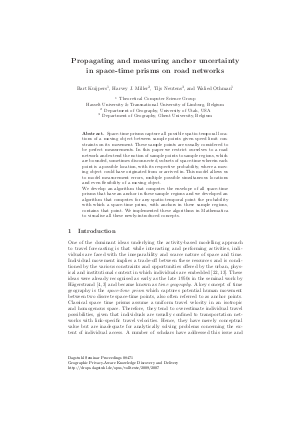Propagating and measuring anchor uncertainty in space-time prisms on road networks
Authors Bart Kuijpers, Harvey J. Miller, Tijs Neutens, Walied Othman
-
Part of:
Volume:
Dagstuhl Seminar Proceedings, Volume 8471
Part of: Series: Dagstuhl Seminar Proceedings (DagSemProc) - License:
 Creative Commons Attribution 4.0 International license
Creative Commons Attribution 4.0 International license
- Publication Date: 2009-05-13
File

PDF
DagSemProc.08471.2.pdf
- Filesize: 1.33 MB
- 35 pages
Document Identifiers
Subject Classification
Keywords
- Space-time prisms
- beads
- prisms
- uncertainty
- flexibility
- time-geography
Metrics
- Access Statistics
-
Total Accesses (updated on a weekly basis)
0PDF Downloads0Metadata Views
Abstract
Space-time prisms capture all possible spatio-temporal locations of a moving object between sample points given speed limit constraints on its movement. These sample points are usually considered to be perfect measurements. In this paper we restrict ourselves to a road network and extend the notion of sample points to sample regions, which are bounded, sometimes disconnected, subsets of space-time wherein each point is a possible location, with its respective probability, where a moving object could have originated from or arrived in. This model allows us to model measurement errors, multiple possible simultaneous locations and even flexibility of a moving object. We develop an algorithm that computes the envelope of all space-time prisms that have an anchor in these sample regions and we developed an algorithm that computes for any spatio-temporal point the probability with which a space-time prism, with anchors in these sample regions, contains that point. We implemented these algorithms in Mathematica to visualise all these newly-introduced concepts.
Cite As Get BibTex
Bart Kuijpers, Harvey J. Miller, Tijs Neutens, and Walied Othman. Propagating and measuring anchor uncertainty in space-time prisms on road networks. In Geographic Privacy-Aware Knowledge Discovery and Delivery. Dagstuhl Seminar Proceedings, Volume 8471, pp. 1-35, Schloss Dagstuhl – Leibniz-Zentrum für Informatik (2009)
https://doi.org/10.4230/DagSemProc.08471.2
BibTex
@InProceedings{kuijpers_et_al:DagSemProc.08471.2,
author = {Kuijpers, Bart and Miller, Harvey J. and Neutens, Tijs and Othman, Walied},
title = {{Propagating and measuring anchor uncertainty in space-time prisms on road networks}},
booktitle = {Geographic Privacy-Aware Knowledge Discovery and Delivery},
pages = {1--35},
series = {Dagstuhl Seminar Proceedings (DagSemProc)},
ISSN = {1862-4405},
year = {2009},
volume = {8471},
editor = {Bart Kuijpers and Dino Pedreschi and Yucel Saygin and Stefano Spaccapietra},
publisher = {Schloss Dagstuhl -- Leibniz-Zentrum f{\"u}r Informatik},
address = {Dagstuhl, Germany},
URL = {https://drops.dagstuhl.de/entities/document/10.4230/DagSemProc.08471.2},
URN = {urn:nbn:de:0030-drops-20072},
doi = {10.4230/DagSemProc.08471.2},
annote = {Keywords: Space-time prisms, beads, prisms, uncertainty, flexibility, time-geography}
}
